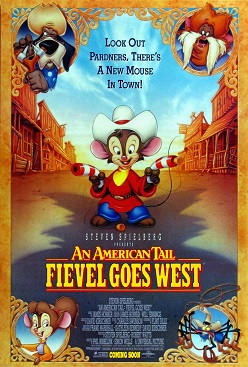An American Tail: Fievel Goes West facts for kids
Quick facts for kids An American Tail: Fievel Goes West |
|
|---|---|

Theatrical release poster
|
|
| Directed by |
|
| Produced by |
|
| Screenplay by | Flint Dille |
| Story by | Charles Swenson |
| Starring | |
| Music by | James Horner |
| Editing by | Nick Fletcher |
| Studio | Amblimation Universal Pictures Amblin Entertainment |
| Distributed by | Universal Pictures |
| Release date(s) | November 17, 1991 (Kennedy Center) November 22, 1991 (United States) |
| Running time | 74 minutes |
| Country | United States |
| Language | English |
| Budget | $16.5 million |
| Money made | $40.8 million |
An American Tail: Fievel Goes West is an animated comedy Western film from 1991. It was directed by Phil Nibbelink and Simon Wells. Famous filmmaker Steven Spielberg produced the movie through his Amblimation animation studio. Universal Pictures released it.
This film is a sequel to An American Tail (1986). It continues the adventures of the Mousekewitz family, who are mice from Ukraine. They have moved to the Wild West. In the story, Fievel gets separated from his family. He meets Sheriff Wylie Burp and helps teach his cat friend, Tiger, how to act like a dog.
Fievel Goes West was the first movie made by Amblimation. Spielberg created this studio to keep the animators from Who Framed Roger Rabbit (1988) working. Most of the animation was hand-drawn, even though computers were becoming popular. Spielberg wanted the animation to feel "live-action."
Many actors from the first film returned, including Phillip Glasser as Fievel and Dom DeLuise as Tiger. New characters were voiced by stars like John Cleese, Amy Irving, and James Stewart. This was James Stewart's last film role. James Horner also returned to compose the music. He wrote the song "Dreams to Dream," which was nominated for a Golden Globe Award.
The movie first showed at the John F. Kennedy Center for the Performing Arts on November 17, 1991. It was released in American theaters on November 22. On the same day, Walt Disney Pictures released Beauty and the Beast. This was one of the few times two animated films opened on the same date. Fievel Goes West earned $22 million in the U.S. and received mixed reviews. Critics praised the animation, humor, music, and voice acting. However, some found the story and pace too fast.
The film did very well when it came out on home video in March 1992. It quickly became a top seller. Over time, Fievel Goes West has gained many fans and is now considered a cult classic. It has also appeared on "best-of" lists from online publications. The movie led to a CBS TV series called Fievel's American Tails. There were also two direct-to-video sequels: An American Tail: The Treasure of Manhattan Island (1998) and An American Tail: The Mystery of the Night Monster (1999).
Contents
The Story of Fievel's Western Adventure
In 1890, five years after moving to the United States, the Mousekewitz family is still struggling. They face attacks from cats who want to eat them. Fievel often dreams about a famous dog-sheriff from the Wild West named Wylie Burp. His older sister, Tanya, hopes to become a singer. Meanwhile, Tiger's girlfriend, Miss Kitty, leaves him to find a new life out west. She wants "a cat that's more like a dog."
Soon, a group of cats, led by the fancy Cat R. Waul, attacks the mouse community. Fievel's family and other mice have to hide in the sewers. There, they meet a mouse in a cowboy outfit. This mouse is actually a puppet controlled by Cat R. Waul. He tricks the mice into thinking they can have a better life out west. Tiger chases the train, trying to catch his friends, but gets lost.
On the train, Fievel goes into the livestock car. He overhears the cats planning to turn the mice into "mouse burgers." When they discover him, he tries to escape and warn everyone. But Cat R. Waul's spider helper, T.R. Chula, throws Fievel off the train. Fievel is left alone in the desert. His family is very sad when they arrive in Green River, Utah, without him.
In Green River, Chula blocks the water tower, making the river dry up. Cat R. Waul tells the mice they should build a new saloon together. He plans to trick them into doing all the work, then eat them. Meanwhile, Fievel and Tiger are both wandering in the desert. They pass each other but think the other is a mirage. Tiger is captured by mouse Indians who think he is a god. Fievel is picked up by a hawk and dropped near the mouse Indian village. He reunites with Tiger. Tiger decides to stay, but Fievel catches a tumbleweed that takes him to Green River.
Fievel quickly finds his family in Green River. However, he cannot convince them of Cat R. Waul's evil plans. Later, Fievel goes into the saloon and hears the cats' plan again. Cat R. Waul discovers him. Before Cat R. Waul can eat Fievel, he hears Tanya singing. He is amazed by her voice.
Cat R. Waul sends Tanya to Miss Kitty, who is now a saloon singer. Miss Kitty encourages Tanya to perform for the cats. While Tanya sings, Chula chases Fievel and briefly captures him. Fievel escapes again.
Outside of town, Fievel talks to an old bloodhound sleeping by the jail. He discovers it is Wylie Burp! Fievel convinces Wylie to help. Wylie agrees to train Tiger to be a lawman and act like a dog. Tiger is not sure at first. But he agrees when he thinks it might help him win back Miss Kitty. They return to Green River to fight the cats. The cats plan to use a giant mouse trap to catch the mice during the saloon's opening.
Tiger, Wylie, and Fievel fight the cats. Miss Kitty and Tanya discover the trap. Tanya rushes to the mice and sings loudly. She knows Cat R. Waul won't trigger the trap if she is there. Her singing warns the mice to run away. Cat R. Waul then uses a giant revolver like a cannon to shoot at the fleeing mice. Wylie launches Fievel onto the gun. Fievel tries to use it against Cat R. Waul. When Chula threatens Miss Kitty, Tiger gets angry. He rescues Miss Kitty and uses Chula's web as a lasso. Tiger throws Cat R. Waul and his men out of town using part of the trap as a catapult. The cats fly into a mailbag, which a passing train picks up.
Miss Kitty and Tiger reunite, happy with his new personality. Tanya becomes a famous singer. The water tower flows again, making Green River bloom with flowers. Fievel finds Wylie, who gives him his sheriff badge. Fievel is unsure, but he realizes his adventure is not over.
Main Characters and Voice Actors
- Phillip Glasser as Fievel Mousekewitz
- Cathy Cavadini as Tanya Mousekewitz
- Dom DeLuise as Tiger
- Amy Irving as Miss Kitty
- James Stewart as Wylie Burp
- John Cleese as Cat R. Waul
- Jon Lovitz as T.R. Chula
- Nehemiah Persoff as Papa Mousekewitz
- Erica Yohn as Mama Mousekewitz
- David Tate as additional voices
The Film's Legacy
In the late 2010s, An American Tail: Fievel Goes West was often listed among the best Western films available on Netflix. It appeared on lists from Paste and The Daily Dot. It was also featured on GameSpot's "25 Best '90s Movies On Netflix." The film was included on a Cosmopolitan list of "50 Movies You Definitely Watched in the '90s and Forgot About."
Bustle called the film "a fun, action-adventure comedy." They also noted it gave Fievel's sister Tanya more screen time. Both Fievel Goes West and the first American Tail were tied for fifth place on a list of best non-Disney films by My Web Times. The article praised their songs and voice acting, including James Stewart in his last role.
The The Jimmy Stewart Museum has shown Fievel Goes West several times. The Autry Museum of the American West also screened the film in 2018. Popular TV shows like 30 Rock, Brooklyn Nine-Nine, and Rick and Morty have mentioned Fievel Goes West.
Other Adventures and Products
Between January and February 1992, Marvel Comics released a three-issue comic book series based on Fievel Goes West.
On September 12, 1992, the TV series Fievel's American Tails started on CBS. It continued the story from Fievel Goes West. Phillip Glasser, Cathy Cavadini, and Dom DeLuise returned to voice their characters. In 2020, NBCUniversal got the rights to the series again. It is now available to stream on Peacock.
Two direct-to-video sequels were made after the TV series:
- An American Tail: The Treasure of Manhattan Island (1998)
- An American Tail: The Mystery of the Night Monster (1999)
Fievel later became the mascot for Steven Spielberg's Amblimation animation studio. He appeared in their production logo. There is also a Fievel-themed playground at Universal Studios Florida. It has a large water slide and oversized objects like books and cowboy boots.
A small LCD game based on the film was made by Tiger Electronics in 1991. A computer game based on the movie was created in 1993. A Super Nintendo Entertainment System video game was released in 1994. It was praised for its look, but opinions on its simple gameplay were mixed. Another video game, An American Tail: Fievel's Gold Rush, came out for Game Boy Advance in 2002.
Film Music and Soundtrack
| Professional ratings | |
|---|---|
| Source | Rating |
| AllMusic | |
| Entertainment Weekly | |
| Film Tracks | |
James Horner composed the film's music. The soundtrack includes the song "Dreams to Dream". This song was nominated for a Golden Globe Award. Entertainment Weekly compared the music to classic Western scores.
Originally, Anita Baker was announced to sing "Dreams to Dream," but this did not happen. Linda Ronstadt first recorded the song. However, she later decided against having her voice on it. Céline Dion then recorded the song. But Ronstadt changed her mind again, and her version was used instead. Horner's experience with Dion led her to sing "My Heart Will Go On" for him later. Ronstadt's version of "Dreams to Dream" reached number 13 on Billboard's Adult Contemporary chart.
The film's music also features a version of the song "Rawhide".
Song List
- "Dreams to Dream (Finale Version)" – Sung by Linda Ronstadt; music & lyrics by James Horner and Will Jennings; produced by David Foster
- "American Tail Overture (Main Title)"
- "Cat Rumble"
- "Headin' Out West"
- "Way Out West"; music & lyrics by James Horner and Will Jennings
- "Green River/Trek Through the Desert"
- "Dreams to Dream (Tanya's Version)" – Sung by Cathy Cavadini; music & lyrics by James Horner and Will Jennings
- "Building a New Town"
- "Sacred Mountain"
- "Reminiscing"
- "The Girl You Left Behind" – Sung by Cathy Cavadini; music & lyrics by James Horner and Will Jennings
- "In Training"
- "The Shoot-Out"
- "A New Land/The Future" (This part is similar to Aaron Copland's "Hoe-Down" theme, using the film's main musical ideas.)
Images for kids
-
An American Tail: Fievel Goes West first showed at the John F. Kennedy Center for the Performing Arts.
See also
 In Spanish: An American Tail: Fievel Goes West para niños
In Spanish: An American Tail: Fievel Goes West para niños




